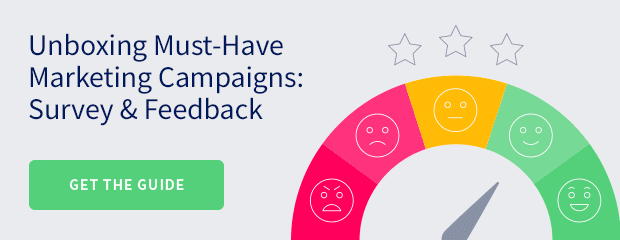In this ongoing series, we’ll be “unboxing” must-have digital marketing campaigns and programs vital to success. In this installment, we’ll take a look at survey and feedback campaigns.
When marketers are asked to provide feedback or take a survey via email, many of us feel compelled to do it.
Why?
Because we’ve been on the other end, hoping and praying for data to move forward on a difficult decision.
Unfortunately, survey design isn’t as easy as it sounds…and writing a compelling message to convince people to take the survey is even more difficult.
Luckily, we have some ideas to help you, the brand marketer, succeed when it comes to sending and designing a high-converting customer feedback survey.
But before we begin, let’s talk about why businesses should ask for feedback in the first place.
The #1 question companies (almost always) forget to ask about surveys
Thanks to the popularity of reviews on Amazon, Yelp and the like, the opportunity to receive immediate feedback on your brand’s products or services is too good to pass up.
Instead of waiting for weeks or months to conduct a panel or focus group, companies can immediately find out what went well and what could be improved. Then they can use that information to target new customer segments or fine-tune their offerings.
In other words, they can get feedback straight from the customer’s mouth themselves—otherwise known as voice of customer (VOC) data.
But that’s just the problem. Inexpensive survey tools like SurveyMonkey and Typeform have made it so easy for companies to execute their own market research via email that often, they forget to ask themselves the following question:
“Once we get this data, where is it going to go?”
It’s too easy to get gung-ho about running a survey, hoard the data and never use or incorporate it into the customer lifecycle.
Not to mention, consumers are inundated by surveys right now, so it’s getting harder to send emails that stand out from the crowd—let alone convince people to do the work of sharing their experience.
Luckily, there’s a path forward. We can share with you three essential ingredients you need before you create a survey/feedback campaign.
Want even more advanced cross-channel tactics? Download our latest guide, Unboxing Must-Have Marketing Campaigns: Survey & Feedback.
3 Essential Ingredients of Survey and Feedback Campaigns
1. A question to answer
We mentioned above that survey and feedback campaigns can be a way to get customer data to move forward on a decision.
However, those decisions are motivated by something much bigger: preventing negative customer backlash.
No company wants to make a decision that hurts their revenue or spend resources producing something that customers don’t value or need.
So whenever you do a survey/feedback campaign, the first thing you should ask yourself should be, “What question are you trying to answer?”
Surveys don’t always need to be multiple questions with a graduate-level analysis.
It can be as simple as one question to break a tie or gauge how effective a company process is.
So, for example, if you’re a publisher like Milk Street Kitchen and trying to figure out which photo to use on the cover of a special issue, you can run a quick survey to your list.
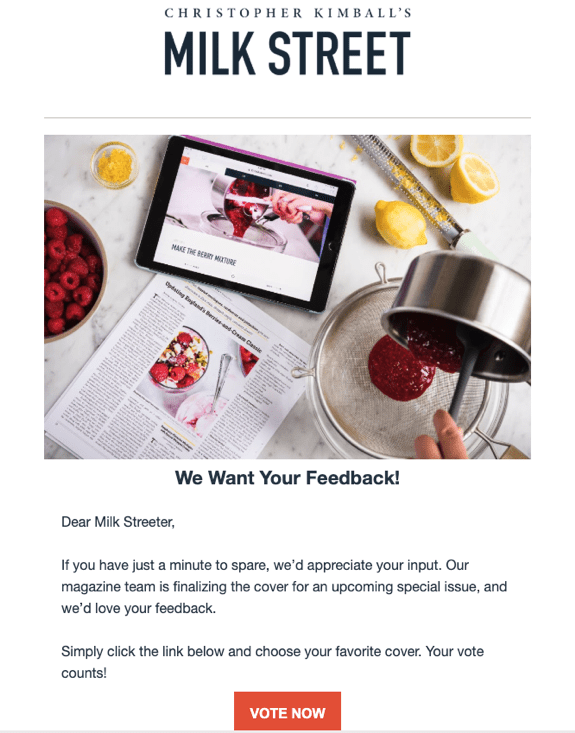

Publisher Milk Street Kitchen uses email to distribute a quick survey on the cover photo of an upcoming issue.
Or maybe you work for a subscription company and want to know why people cancel, like meal kit subscription service Sun Basket does. They automate a transactional email to those who discontinue service, by simply asking for replies in the body text of the message.
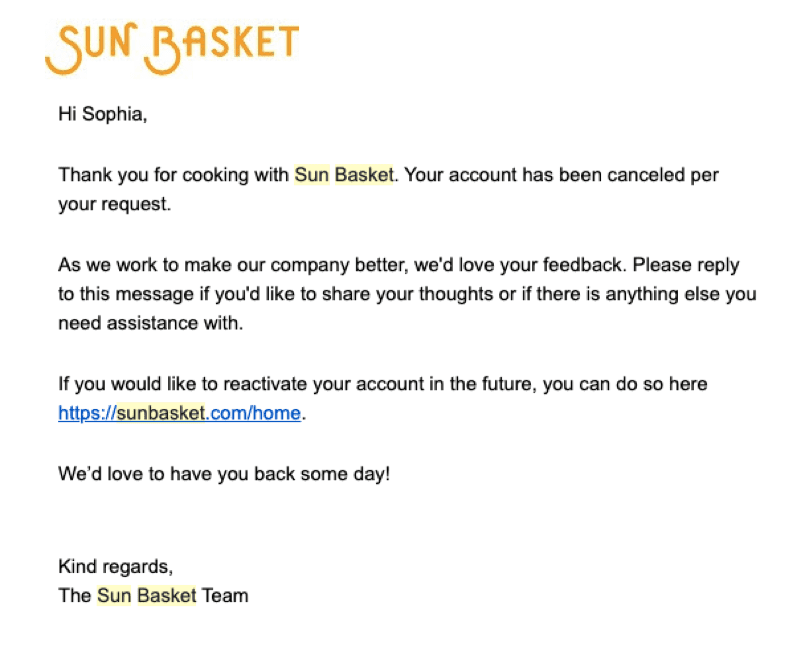

Meal-kit subscription service Sun Basket asks for feedback from canceling customers.
Another way to automate feedback via email is by incorporating it into your help desk software, like e-commerce site Food52 did. Doing this can help you answer questions, like which support agents have more satisfied customers than others, what types of issues do customers contact support about and more.


E-commerce site Food52 sends emails to users after they contact customer support, asking whether they were satisfied with the level of service.
Regardless of how you initiate the survey, asking for feedback or running a survey always starts with a question your team wants to answer.
2. An irresistible offer
Even when you’re thinking about surveys, you have to think about what’s in the recipient’s best interest.
And even though your survey only takes five minutes, it could be five minutes the recipient doesn’t have to waste on you.
That’s where an irresistible offer comes in.
Offering compensation in exchange for your opinion has long been a practice in market research circles. The only difference now is that as a brand, you don’t have to pay a firm to put together (and compensate) a panel of consumers.
You can do it yourself.
It doesn’t have to be money per se, but it has to be in the interest of someone to spend the time to take your survey.
The most popular option for compensation in exchange for taking a survey is a gift card. See how onboarding platform AppCues used a Starbucks gift card (and an eye-catching subject line) to get survey responses.
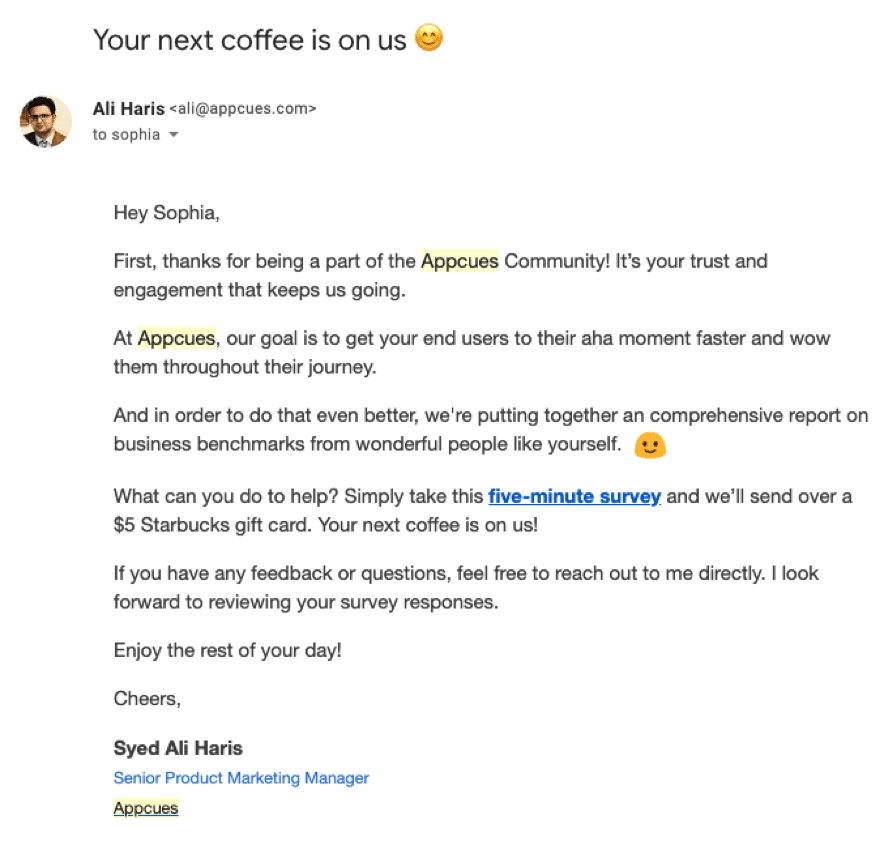

Onboarding platform Appcues offers Starbucks gift cards to anyone willing to take their survey.
Of course, it doesn’t always have to be money for coffee. If you already know you have an engaged list of customers, you can give them a voucher for your service.
For example, if you are a freemium software company like video collaboration tool Loom is, you can offer a trial of your paid plan.
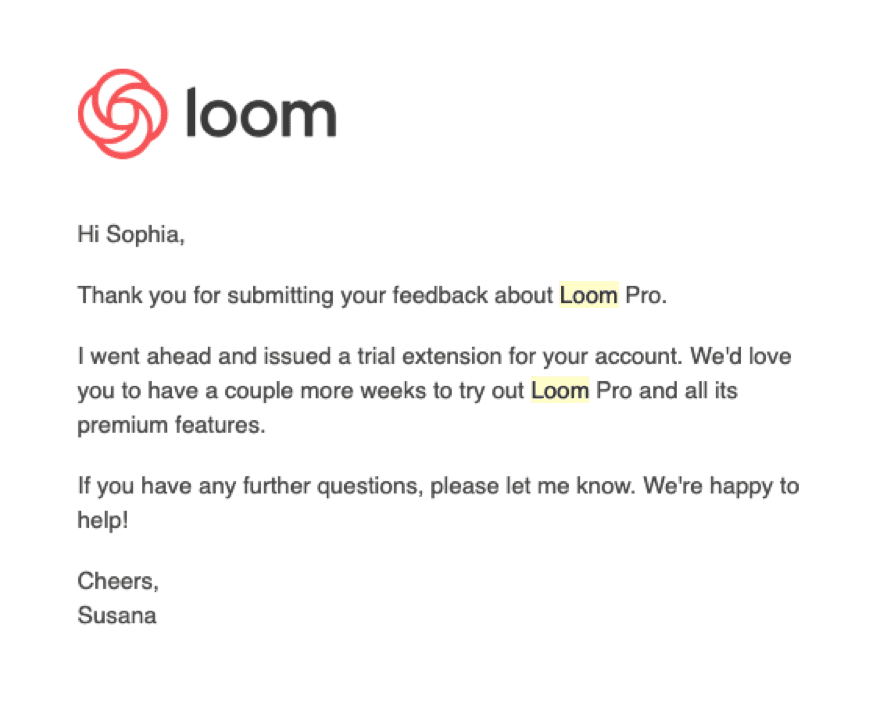

Video collaboration tool Loom offers trials of their paid plan as a thank you to users who gave feedback.
Or if you’re selling high-ticket items like furniture, you can offer coupons for future purchases, like Design Within Reach does.
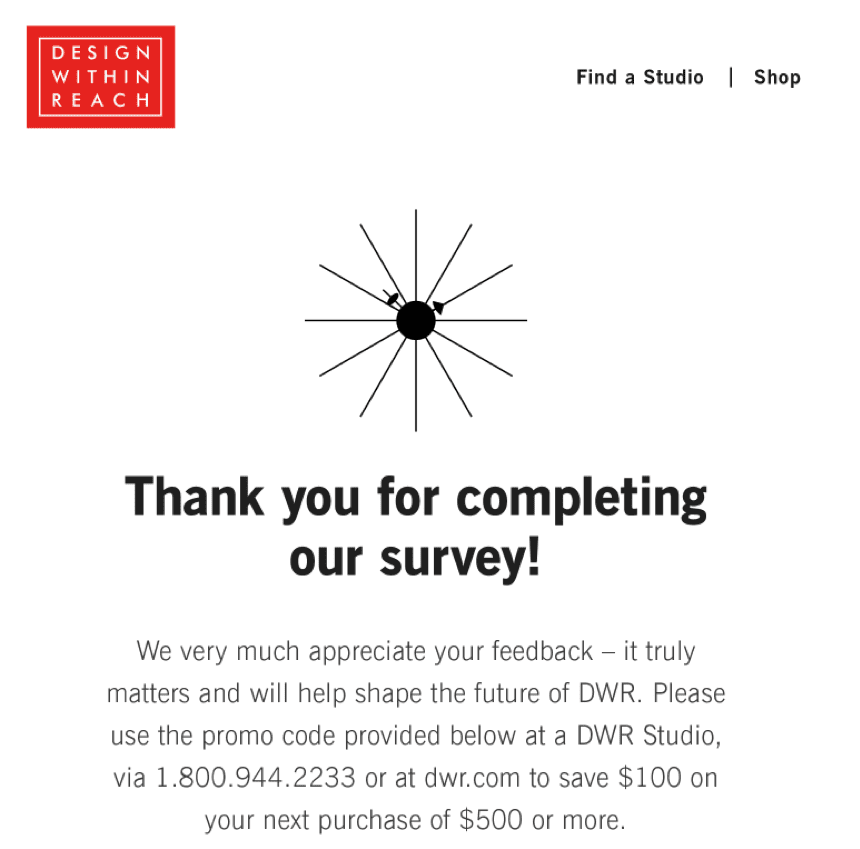

Furniture company Design Within Reach gives out coupons on future purchases as a thank you to survey takers.
Irresistible offers aren’t always a surefire way to get a good sample size though—the wrong type of compensation can lead to a voluntary response bias, where your sample size consists of people only interested in taking advantage of an offer over providing insightful feedback.
If you offered Starbucks gift cards as an incentive, then you might leave out people who didn’t like Starbucks in your data…and they might have different things to say than the people who like Starbucks (and want a free coffee).
It sounds nitpicky, but it’s always something to consider when you’re doing research. Whatever gift you choose, make sure to offer something enticing enough to get a good sample size without compromising the integrity of the data.
3. Something to measure
Not all survey campaigns ask for freeform text as feedback.
When your question needs data that only hard numbers can provide, this is when you bust out questions that have your respondents ranking how they feel on a scale of sorts.
There are many ways to do this, but the two most commonly used by growth-driven consumer brands include Net Promoter Score and Likert scale.
Net Promoter Score (NPS)
The first is the Net Promoter Score (NPS). Developed by consulting firm Bain & Co, the general idea is that happy customers recommend brands to their friends and colleagues.
Respondents respond on a scale of 1-100 about their likeliness to make a recommendation, and the brand takes those scores and groups them into three different categories:
- Promoters (90-100): Loyal and enthusiastic fans. They love your product or service and spend all of their time telling their friends and colleagues.
- Passives (60-80): Satisfied (but not necessarily loyal) customers. They’re happy but could be persuaded by cheaper prices or shiny features from a competitor.
- Detractors (0-60): Unhappy customers. They hate your product or service, will probably leave and have no issues telling their friends and colleagues why.
It’s also easy to calculate—it’s simply the percentage of promoters subtracted by the percentage of detractors.
The higher an NPS score is, the less likely your customers will churn on you.
You can see the usage of Net Promoter Score in practice in the body of an email template, like food delivery service Goldbelly does.
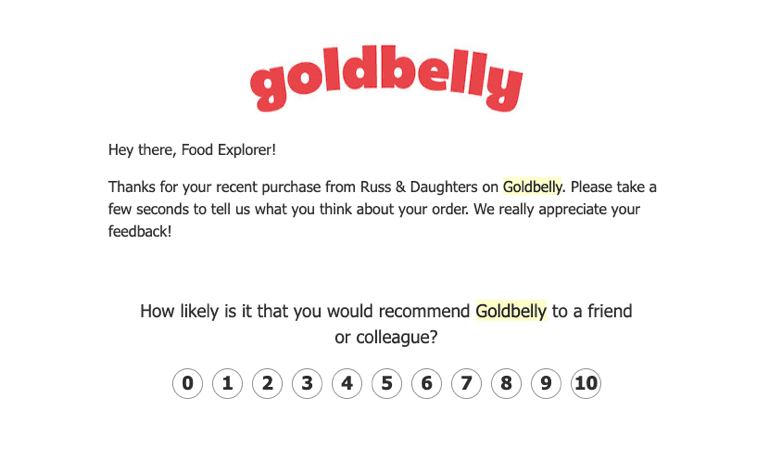

Food delivery service Goldbelly uses the above email to measure Net Promoter Score for first-time purchases.
Once respondents choose their number, they are taken to the landing page below and asked to write in why they chose that number.
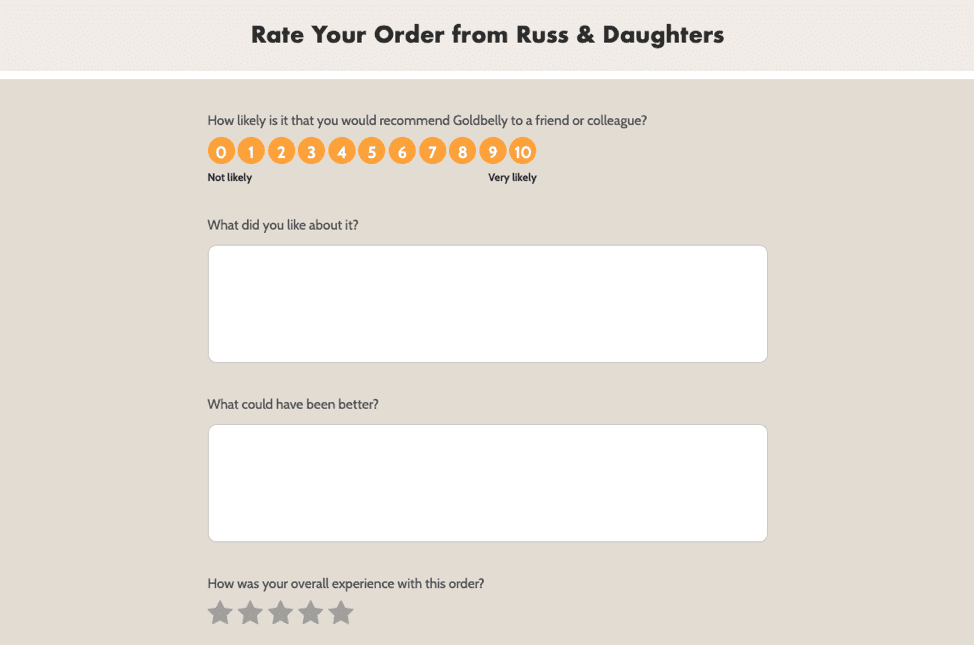

For respondents who want to give more feedback, Goldbelly offers options to write in additional comments using the above form.
Goldbelly knows that customers don’t buy specialty foods every day, so they rely heavily on paid ads and their referral program to acquire new customers.
By using NPS, Goldbelly can quickly gauge how happy first-time purchasers are, tie it directly to voice of customer (VOC) data, and open up possibilities for referral email campaigns later on.
Likert scales
If you’ve ever taken a survey, you’ve done a Likert scale (also known as rating scales).
Named after American social scientist Rensis Likert, Likert scales ask respondents to rank their level of agreement on a series of statements provided by the brand.
This was a game-changer in the social science world.
Why? Because now researchers could ask questions beyond a simple “Yes/No” question—and had more analytical substance than a blank text box.
So for instance, clothing retailer Gap once asked us to provide some feedback on new baby and toddler clothing designs.
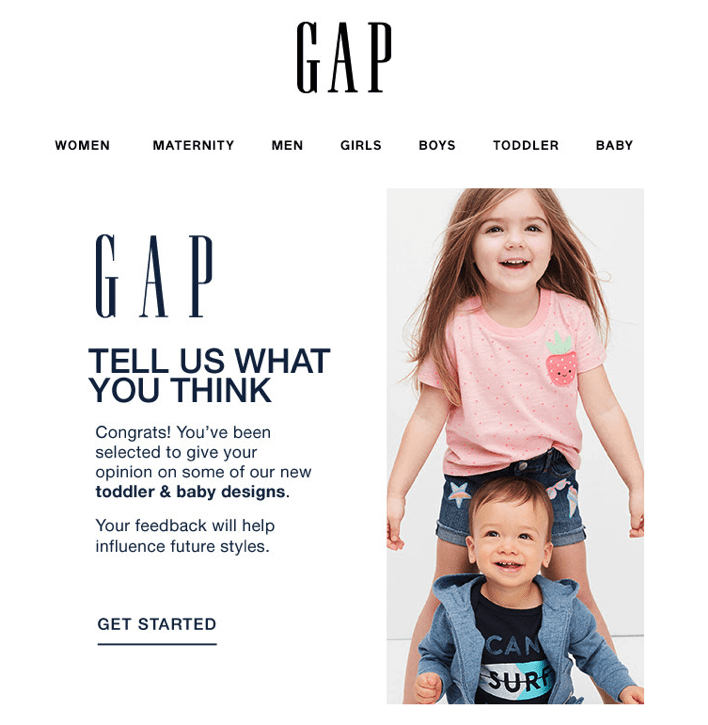

Gap wanted our opinion on new toddler and baby designs.
Once we clicked on their link, they showed us a series of designs and asked us what price we’d be willing to pay, as well as whether we liked it, hated it, or felt neutral about it.
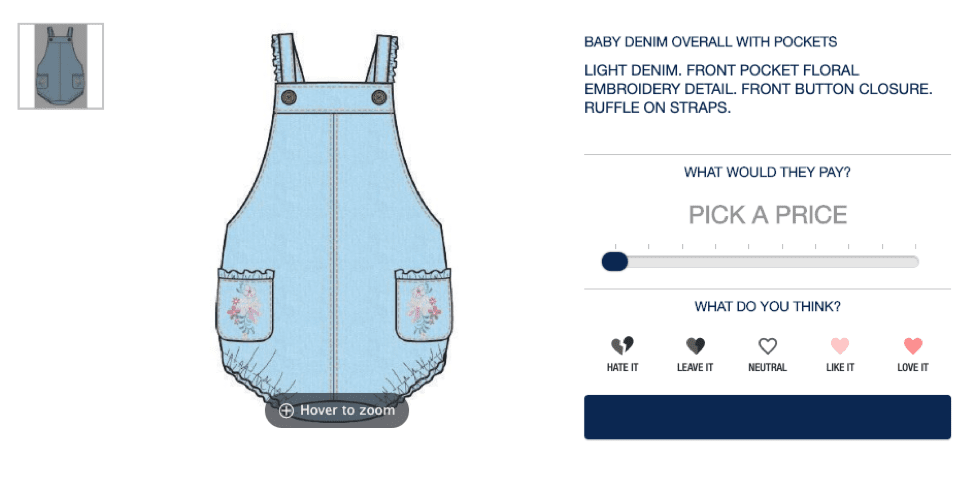

Gap uses a visual Likert scale to ask our opinion on prospective baby clothes designs.
Thanks to a Likert scale survey, Gap can get direct feedback on designs that resonate with potential customers—and manufacture clothing in a much more efficient manner than before.
So whether you’re using Likert scales or Net Promoter Scores, your team (and your C-suite) will appreciate numerical data as a result of running a survey; it makes things easier to measure than unstructured text data.
Now, a Recap
Despite the problems associated with running surveys, they are still an incredibly valuable tool to help brand marketers make decisions.
If you’re just getting started with survey/feedback campaigns, remember that you need these three essential ingredients for the best results:
- A question to answer
- An irresistible offer
- Something to measure (either Net Promoter Score or Likert scales)
Go beyond the basics and download our full guide to building high-converting survey and feedback campaigns that stand out from the crowd.
Inside, you’ll learn how to leverage text messaging (SMS), in-app notifications and direct mail for personalized cross-channel campaigns.
We’ll also reveal how to tackle recognition and rewards for customer service reps and offer even more survey inspiration from today’s leading brands, so don’t miss out and grab your copy today!































